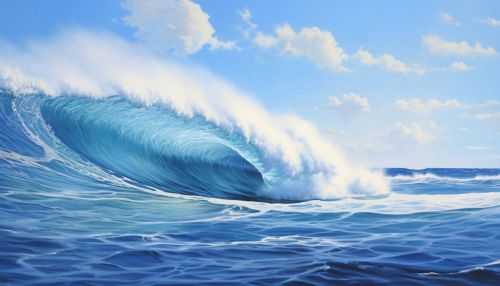Swell (Ocean)
Introduction
The ocean swell, commonly referred to as a swell, is a series of mechanical waves that propagate along the interface between water and air. These waves are generated by distant weather systems where wind blows for a duration of time over a significant area of water, causing the water to 'swell'. Unlike surface waves that are generated locally, swells have a more stable and predictable pattern, making them a significant feature of the open ocean.
Formation of Swells
Swell formation is a complex process that involves several stages. The initial stage is the generation of wind waves by local winds. These waves are irregular and chaotic, with a wide range of wavelengths and directions. As these waves move away from their source, they begin to sort themselves out into groups of similar speed and direction, a process known as wave dispersion. This results in the formation of swell waves, which are more regular and organized than wind waves.
The energy that drives swells comes from the wind. When wind blows across the surface of the ocean, it transfers some of its energy to the water, creating waves. The size of these waves depends on the wind speed, the duration of time the wind has been blowing, and the fetch, which is the distance over which the wind has been blowing.
Characteristics of Swells
Swell waves have several distinctive characteristics that set them apart from other types of ocean waves. These include their long wavelengths, regular and predictable pattern, and their ability to travel vast distances across the ocean.
Wavelength and Period
One of the defining characteristics of a swell is its long wavelength. The wavelength of a wave is the distance between two successive crests or troughs. Swell waves typically have wavelengths of hundreds of meters, much longer than wind waves. This long wavelength is a result of the wave dispersion process, where waves of similar speed and direction group together.
The period of a swell wave, which is the time it takes for two successive wave crests to pass a fixed point, is also typically longer than that of wind waves. Swell periods can range from 10 to 20 seconds, compared to 5 to 10 seconds for wind waves.
Propagation
Swell waves can travel vast distances across the ocean, a characteristic known as swell propagation. This is due to their long wavelengths and the deep water wave conditions under which they form. Under these conditions, the speed of a wave is proportional to its wavelength, so swell waves travel faster and further than wind waves.
Predictability
Unlike wind waves, which are chaotic and unpredictable, swell waves have a regular and predictable pattern. This is because they are generated by distant weather systems, rather than local winds. This makes swells a valuable tool for surf forecasting, as they can provide an indication of upcoming surf conditions.
Impact of Swells
Swell waves have a significant impact on a variety of oceanic and coastal processes. These include wave breaking and surf, coastal erosion, and the transport of sediment along the coast.
Wave Breaking and Surf
When swell waves reach shallow water, they begin to interact with the ocean floor, causing them to slow down, increase in height, and eventually break. This process, known as wave breaking, results in the formation of surf. The size and power of the surf depends on the characteristics of the swell, including its height, period, and direction.
Coastal Erosion
Swell waves can also contribute to coastal erosion. When these waves break, they generate a powerful force that can erode the shoreline, particularly during storms when the swell is large and powerful.
Sediment Transport
Swell waves play a key role in the transport of sediment along the coast, a process known as longshore drift. This occurs when the swell hits the beach at an angle, causing the sediment to move along the beach in the direction of the wave.
Measurement and Forecasting
The measurement and forecasting of swells is an important aspect of oceanography and meteorology. Various methods and technologies are used to measure swells, including buoys, satellites, and wave models. These measurements are used to forecast swells, which is crucial for a variety of activities, including shipping, fishing, and surfing.
See Also


